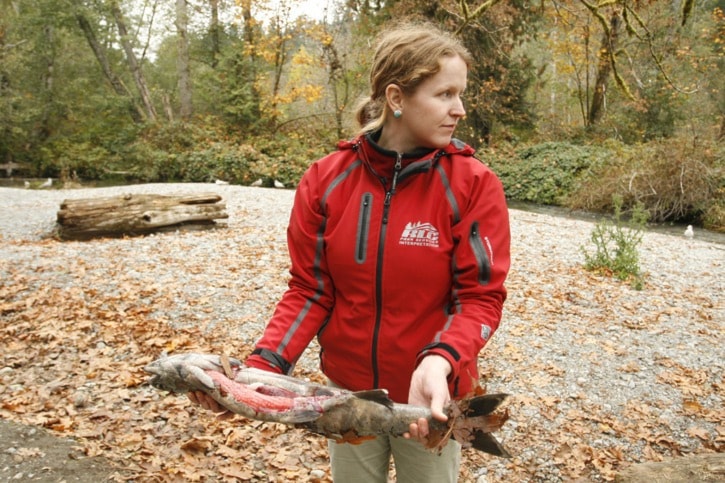After a few more seasons, chinook salmon are expected to be gone for good from Goldstream River.
The Goldstream chinook run is over for the year and volunteers have counted less than 20 of the fish at the hatchery’s Japanese weir fish trap.
“The chinook run was dreadful, it’s on the verge of extirpation (local extinction),” said Peter McCully, a fisheries technician with the Goldstream hatchery. “Some years we’ve had chinook counts as high as 300 to 500. Now they are barley hanging on. We are seeing the end of the chinook.”
While chinook are on the demise, spawning chum are coming in strong at Goldstream Provincial Park. A total of 9,000 chum, alive and dead, have been counted in the river.
It's healthier than last years disastrous return of 4,800 fish, but still no where near previous years. In 2009, 19,000 chum made their way to their spawning grounds and 32,000 swam up the river in 2008.
“This time last week we had 1,200. So they are starting to take off,” McCully said on Tuesday. “We’ve already exceeded last year’s numbers. Last year was terrible.”
Numbers could increase once rain starts to pour. An ideal year for chum would be about 20,000 fish returning to the river. “We are partially there,” McCully said. The peak time for the chum return is Nov. 12 to 14.
As for coho salmon, the run is off to a slow start, but McCully is waiting for the numbers to improve when the water levels rise due to seasonal rains. The coho run usually spans through November and December.
“The salmon like lots of water so we do need some rain,” remarked Goldstream park naturalist Alli Roberts.
Hatchery volunteers have counted 80 coho salmon in the river. Last year at this time, there were 400, but McCully said it’s too early to be worried.
The 42,000 litres of gasoline and 700 litres of diesel that gushed into Goldstream river on April 16 doesn't appear to be affecting this year's salmon run. Trace amounts of hydrocarbons remain in the river, but with erratic salmon return rates in past years, it will be difficult for river watchers to discern the long term impact of the fuel on the run.
In the meantime, while some salmon are waiting for rain before coming upstream, kids and nature lovers are filing into the park in large numbers, largely due to the nice weather. “The colour of the park with all the maple leaves and the sunshine, you can’t beat it,” Roberts said.
On his way to a gig in Nanaimo, three-time Juno award winner David Francey and his band pulled off the highway to see the salmon run. The three band mates from Ontario had never seen a salmon run, or Goldstream Provincial Park.
“Is is amazing, I love it,” said Francey, pointing at the fish swimming upstream.
The Goldstream Nature House and park naturalists are keeping busy with up to 10 school groups coming through the park each day.
“Every half hour we have a new class coming though here,” Roberts said. “It’s about 300 kids a day. Kids become little advocates for the salmon and for nature itself.”
Right now people can witness the salmon finding space and wriggling away silt to lay and fertilize eggs. In a few weeks carcasses will line the river, attracting eagles.
“By mid-November it’s mostly dead ones and if you don’t mind stinky fish then come in December,” Roberts said.
Naturalists warn that large black bear is wandering Goldstream park mainly in the estuary area, but its also been seen walking along the river.
reporter@goldstreamgazette.com
